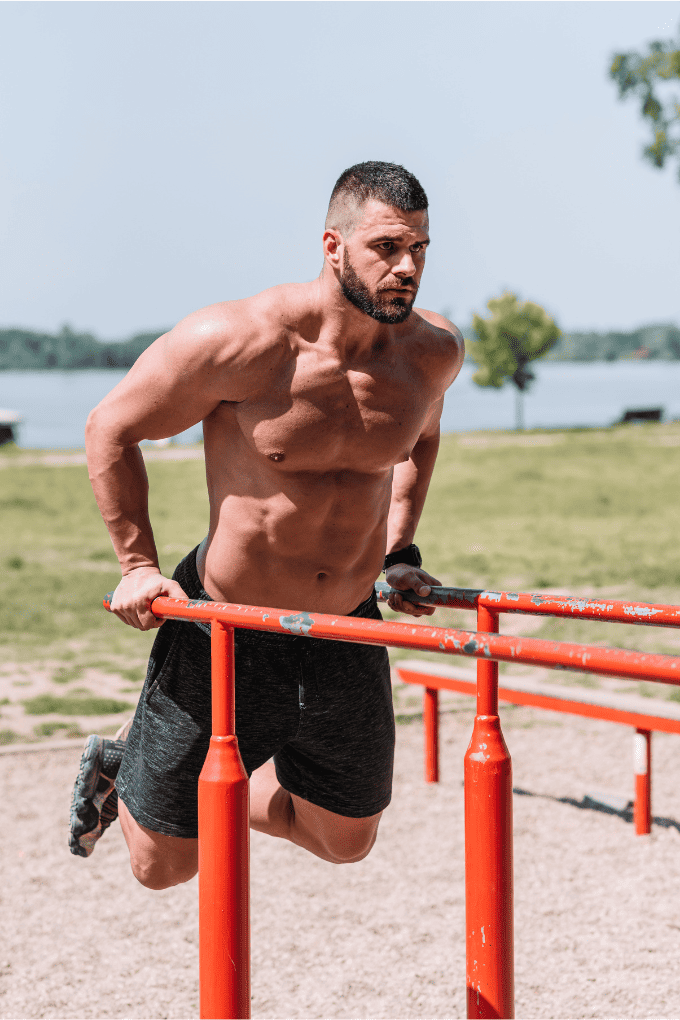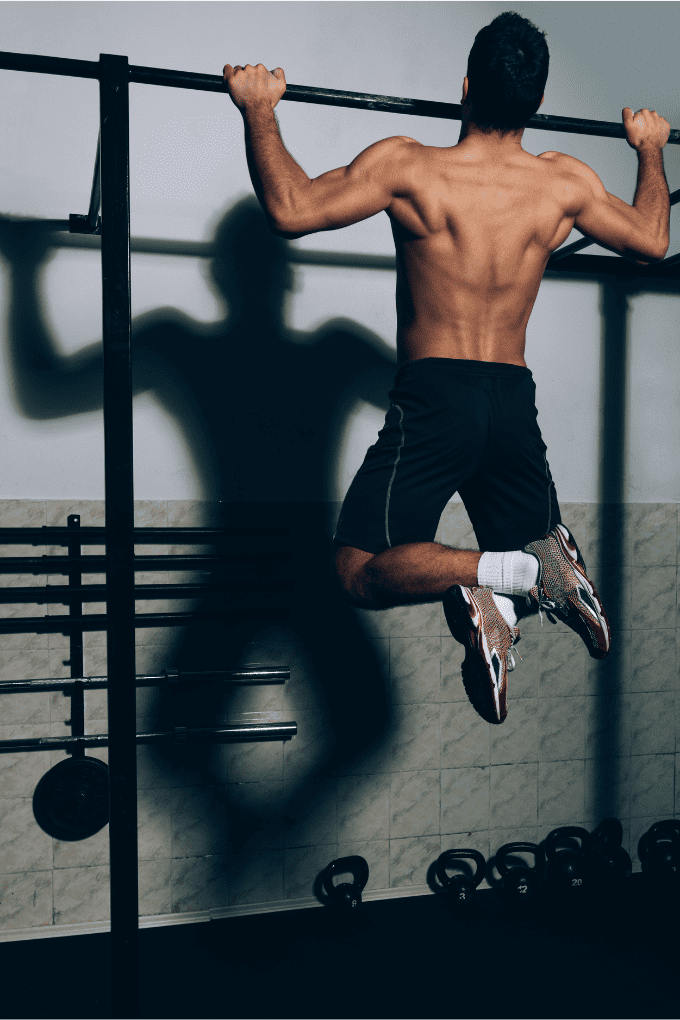10 Best Bodyweight Exercises for Football Players
Football players often carry the misconception that bodyweight exercises are not nearly as effective as hitting the gym and lifting heavy weights.
However, bodyweight training can offer an unbeatable combination of flexibility, balance, and core strength, elements vital on the football field.
Now, don’t get me wrong, I’m not saying you should stop doing Cleans and Back Squats.
But, incorporating bodyweight movements into your training is something I highly recommend. And, if you should ever find yourself without access to a gym or gym equipment, you can still get in a great workout with no equipment whatsoever.
In this article, I’m going to share with you the ten best bodyweight exercises for football players. Most of which you can start doing today (even right now!).
Best Bodyweight Exercises for Football Players
Here they are, in no particular order, my 10 favorite bodyweight exercises for football players.
Stick around to the end because I put these 10 exercises into a workout circuit that you can try out right now.
Push-Ups

Why: Push-Ups target the chest, shoulders, and triceps, promoting upper body strength necessary for powerful tackles and protecting the ball.
Push-Ups aren’t just one of my favorite bodyweight exercises, they are one of my favorite upper-body exercises for football players, period.
How To
- Lie face down on the floor.
- Pull your toes in so that you’re on the tip of your shoes.
- Eyes should be focused straight down or slightly up.
- Pull your hands close to about the nipple line of the chest and bring them out about 2-3 inches away.
- Take a deep breath, engage the core and brace.
- Push yourself up in one unit. There should be no sagging of the waist. The entire body from head to toe should move up and then back down in unison.
- Feel your scapula upwardly rotate and make sure the antagonist muscles (Back and biceps) are fully engaging.
- Lock out your push-up and pause.
- Slowly lower yourself back down and get ready for the next repetition from just above the ground. Do not fully relax at the bottom of the push-up unless your program specifies.
Bodyweight Squats

Why: Bodyweight Squats build strength in the legs and core, enhancing stability and power in the lower body, which is vital for sprinting and jumping.
How To
- Perform your bodyweight squat by placing feet shoulder width apart, toes straight ahead or slightly pointed out.
- Squat down by first hinging the hips back and then bending the knees and dropping the hips straight down.
- Chest should stay up, eyes focused straight ahead.
- Feet should remain flat on the floor with weight evenly distributed between the heel and ball of the foot.
- Stand tall by pushing the feet ‘through the floor’, driving the hips up and the shoulders tall.
Burpees

Why: Burpees offer a full-body workout, improving cardiovascular endurance, and agility, which are crucial for maintaining conditioning throughout the game.
How To
- Stand with your feet shoulder-width apart and your hands by your sides.
- Lower your body into a squat position by bending your knees and hips. Place your hands on the ground in front of you, just outside shoulder-width apart.
- Jump your feet back into a plank position, with your hands still on the ground and your body in a straight line.
- Do a push-up by lowering your chest towards the ground, then pressing back up to the plank position.
- Jump your feet back towards your hands, then stand (or jump) up and reach your arms overhead.
Planks

Why: Planks strengthen the core, enhancing balance and stability, which is essential in maintaining a strong posture during gameplay.
How To
- Start on the ground on your stomach.
- Assume a push-up like position on your elbows and toes. Elbows should be directly under the shoulders.
- Position your body in a straight line from the shoulders through the hips, knees and ankles.
- Brace the core tight. (As if you’re going to be punched in the stomach)
- Do not let the body slouch to the ground nor push the hips up high in the air.
Mountain Climbers

Why: Mountain Climbers engage core muscles while also working the hips and legs. This functional exercise enhances both agility and core strength.
How To
- Begin in a push-up position – hands under shoulders, core engaged, body in a straight line
- Now raise one knee toward the chest and place the ball of the foot on the ground – from this position you’re ready to begin performing reps.
- Drive one leg up and place the foot right next to where the opposite foot just left.
- Simultaneously extend the ‘up foot’ back to the original starting position.
- Continue alternating back and forth until all reps are completed.
Lunges

Why: Lunges work on the quadriceps and hamstrings, aiding in the development of strong and stable legs, which are fundamental for drive blocking and breaking tackles.
How To
- Stand upright with feet hip-width apart, shoulders relaxed and engage your core
- Step forward with one leg and lower your body, bending both knees at 90 degrees.
- Front knee above ankle, not past toes. Back knee close to but not touching the ground.
- Push off the front foot and return to the start position. Alternate legs each rep.
Glute Bridges

Why: Glute Bridges target the gluteal muscles and hamstrings, improving hip mobility and stability, which are vital for sharp turns and sprints on the field.
How To
- Start by laying on your back on the ground.
- Bend both knees to about a 90-degree angle and place both feet flat on the floor.
- Begin the rep by driving your hips up into the air. Try to attain a straight line from the shoulders through the hips and knees.
- Squeeze the glutes at the top of the rep and then lower back down to the starting position.
Russian Twists

Why: Russian Twists focus on the core, particularly the obliques, which assists in developing a strong torso, essential for protecting the ball and enhancing rotational power.
Coach’s Note: A Medicine Ball can add an element of resistance (pictured above) but isn’t necessary for Russian Twists to still be effective.
How To
- Start by taking a seat on the floor and clasping your hands together.
- Slightly bend the knees and raise your feet roughly six inches off the floor.
- Start by rotating your torso to the left, taking your right elbow toward your left knee.
- Now turn your shoulders and rotate your torso to the right, now taking your left elbow toward your right knee.
- Keep legs mostly still and maintain the feet off the floor throughout the movement.
- Continue rotating back and forth until all reps are completed.
RELATED –> My 10 Favorite Core Exercises for Football Players
Dips

Why: Dips focus on the arms (specifically the triceps), aiding in the building of upper body strength necessary for blocking and tackling.
Dips are tricky, because yes they’re bodyweight, but they also require a piece of equipment. Worst case scenario, grab a chair or bench and do Bench Dips.
How To
- Attach your dip rack to your rack. This process will vary based on your rack and dip attachment. Follow the manufacturer’s instructions closely.
- Set your dip rack just above waist height. This will allow enough room for your feet not to hit the ground while doing reps, but not so high you feel you have to jump up into your first rep.
- Starting position is hands on bars, arms extended, knees slightly bent and feet crossed (crossing feet is optional but does help with unwanted swinging in my experience.
- Descend down by bending the elbows and slightly leaning forward.
- Lower yourself under control until the triceps become parallel with the ground and then drive yourself back up to the starting position.
Pull-Ups

Why: Pull-Ups are quintessential in building upper body strength, targeting the back, shoulders, and biceps muscles.
Like Dips, Pull-ups are a bit tricky to classify as bodyweight or not.
Yes, technically you need a pull-up bar (or anything similar that can work as one), but Pull-ups are still a bodyweight exercise and they’re just too good to leave off the list.
How To
- Approach the pull-up bar and grab the bar with a pronated grip (palms facing away).
- Use a bench to get to the bar if it is too high.
- Later in the article, I will talk about variations, alternatives, and modifications where the supinated (palms facing in) grip will be discussed.
- Squeeze the bar and engage the core muscles and do not cross your legs.
- Engage the upper back and pull up until your chin is over the bar.
- Pause for 1 second with your chin over the bar.
- Slowly lower yourself back to the starting position.
Bodyweight Circuit
Here’s a bodyweight circuit that you can follow to build strength and endurance utilizing the exercises above:
| Circuit 1 | 3 Rounds |
| Push-Ups | x 15 |
| Bodyweight Squats | x 15 |
| Burpees | x 12 |
| Plank | x 45 seconds |
| Circuit 2 | 3 Rounds |
| Mountain Climbers | x 15 each leg |
| Russian Twists | x 15 each side |
| Glute Bridges | x 15 |
| Circuit 3 | 3 Rounds |
| Pull-Ups | x 10 |
| Lunges | x 12 each leg |
| Dips | x 10 |
Circuit Instructions
Make sure to start off with a proper warm-up. I have a few sample warmups here if you need one.
Perform each exercise in Circuit 1 one after another, with minimal rest in between, until 3 total rounds have been completed.
Rest 2 minutes.
Continue on to Circuit 2 in the same manner, resting another 2 minutes between Circuit 2 and 3.
If you want to increase the challenge, try 4 rounds of each circuit instead of 3.
Want something more advanced? Check out these football workouts for power and strength development.

Online Strength Programs
- 1-on-1 Online Coaching
- Sports Performance Programs for Football, Basketball, Soccer & More
- Programs for Former Athletes (Legends) Who Still Want to Train Like Athletes
- Programs for Adults Who Want to Get Healthy (and look great at the beach!)
- Use Code “HB10” to Get 10% Off Today
Final Thoughts
The strategic incorporation of bodyweight exercises into a football player’s training program can foster indispensable agility, strength, and endurance.
This is especially true for those times when you don’t have access to a weight room.
By regularly performing these exercises, players can not only enhance their performance on the field but also reduce their chance of potential injuries.

